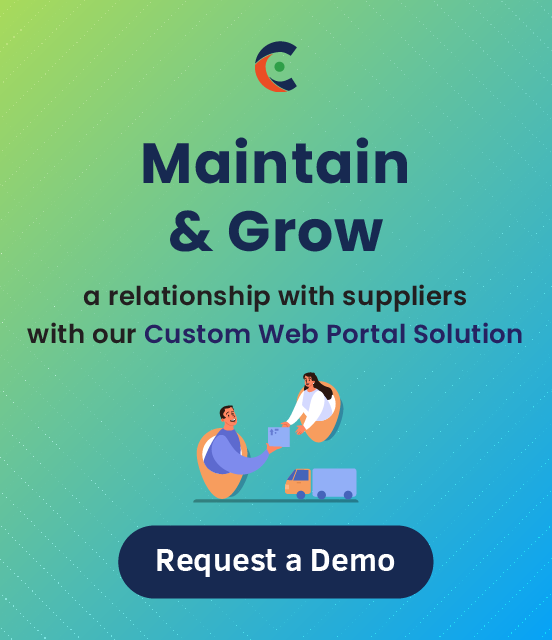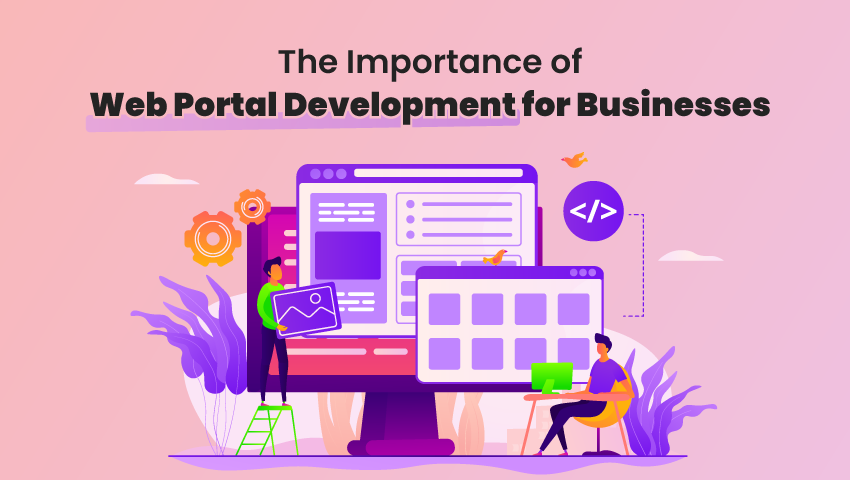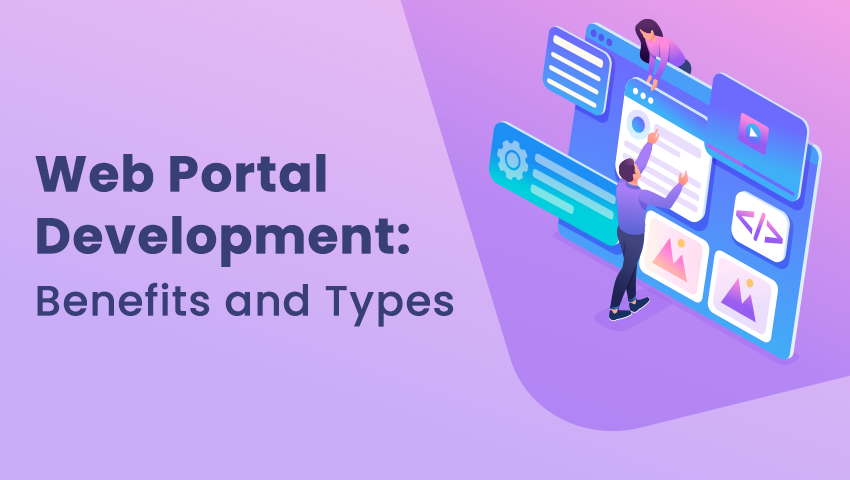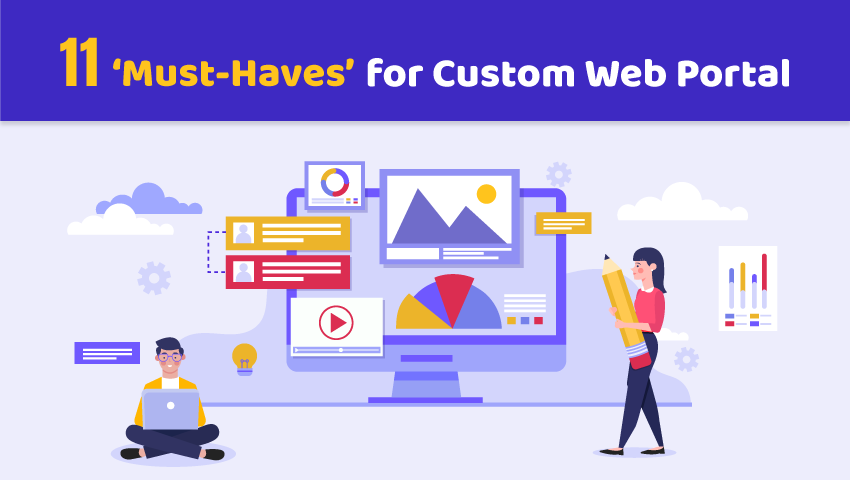eLearning portals like Coursera and edX are very popular among professionals and students. Why? People across geographies enroll in online courses for several reasons. One is that these online learning portals can be used by anyone. And two, they can be accessed anywhere! The other most prominent reason why e-learning portals are getting so much love is that they allow people to learn at their own pace.
Educators, academic trainers, and coaches can use these learning portals to sell their courses online, share knowledge, and make money from the enrollments. Even traditional academic institutions, in humongous numbers, are opting for e-learning web portal development. Why? To provide students with a centralized hub to access learning materials like ebooks, video-recorded sessions, etc.
Here’s a fun fact about e-learning and digital education:
The global e-learning industry is predicted to grow to US$400 billion by 2026! The United States will be one of the top countries to generate the highest revenues for e-learning businesses after China.
So, if the popularity and earning potential of e-learning platforms are rising, does that mean that you can opt for web portal development and launch an online educational hub?
Let’s find out!
What are eLearning Web Portals? A Brief Intro
An e-learning web portal is a digital platform that offers online learning and education materials or information. These centralized platforms can be used by anyone—professionals, students, and learners—to access courses, educational information, and other resources.
The best example of an e-learning platform is Coursera.
This e-learning portal offers courses from various disciplines, such as healthcare, technology, personal development, the arts, math, and more.
Anyone can go to Coursera’s website, log in, browse the available courses of their choice, complete the sessions, and get certifications. It is an excellent example of what users can do on an e-learning web portal. Besides, users can also track their progress, edit their profiles, manage subscriptions, access their knowledge base, and much more from the portal itself.
Source: KPMG Report
In a nutshell, an e-learning portal offers a convenient and adaptable platform for people to learn, upskill, and participate in education activities “remotely.”
Also, did you know that you can develop two other types of e-learning web portals apart from a simple online course platform?
Let’s explore them.
Types of eLearning Portals
You can undertake web portal development for three types of learning platforms.
Learning Management System (LMS)
LMS is commonly used by educational institutions or businesses that provide online courses, certifications, or degrees. According to a survey, about 83% of organizations use an LMS. The web-based system has multiple features and functions to help learners track their progress and manage materials like assignments, notes, etc.
Additionally, LMS comes in handy for managing leaves and lectures, accessing video-recorded sessions, viewing grades, and much more.
Some of the popular examples of LMS are:
-
Moodle
-
Canvas
-
Docebo
-
360 Learning
Learning Marketplace
The online learning marketplaces connect educators and learners. Generally, learners use these marketplaces to book one-on-one sessions with tutors they like. How does it work? Well, it’s simple.
The learner needs to search for the subject or topic they wish to learn. Based on the entered keyword, the system will list down all the tutor profiles so users can see their ratings and reviews. They can compare the profiles and, finally, book the sessions with the selected tutor and get on a 1:1 video call.
Some of the popular online learning marketplaces are:
-
Chegg Study
-
eTalk School
-
Preply
Online Course Platform
Learners can access a variety of video courses through these platforms. They can easily find the course they want to opt for by checking the demo videos and seeing the ratings and reviews given by past or fellow learners.
These e-learning websites also offer certifications after learners complete the course.
Some of the widely used e-learning course platforms are:
-
Udemy
-
Skillshare
-
Linkedin Learning
-
Thinkific
eLearning Web Portal Development – Exact Steps to Follow
You can build the best online educational platform by following the appropriate web portal development steps.
What is web portal development in general? The concept of web portal development involves building a digital space for customers or partners that is easy to use and effective.
Let’s learn how to build an e-learning web portal for your business:
Define your goals
When starting with web portal development, the foremost thing is to identify and define your goals. It seems to be a tedious task, but here’s what you should do to do this without any loopholes:
-
Determine what purposes your e-learning portal will serve. Will it help people learn and earn certificates? Will the platform let learners find and book personal tutors? Or will it allow institutions to manage their students, documents, scores, etc.?
-
Know who your target customer is.
-
Decide what content you wish to provide on your platform. Will it include pre-recorded video classes, live classes, etc.?
Choose the platform or development partners
Creating an e-learning portal isn’t easy, but when you have the right professionals to build it, you can rest assured that you will receive the highest quality.
So, when building your e-learning web portal, consider the following factors to find the best professional for the job. These factors will also help you pick the right platform, such as Moodle, Blackboard, Canvas, WordPress, Drupal, etc.
-
Cost: Calculate the initial and ongoing costs of web portal development. Also, evaluate the potential ROI in advance.
-
Functionality: Ensure that the professionals provide all the core and advanced features in your e-learning web portal. For instance, the portal must have functions for staff/student management, document/assignment management, knowledge base, finance and event management, etc.
-
Salability: Consider the potential of scalability when choosing the platform. Ensure that the system supports unlimited users and content storage and doesn’t crash in cases of high traffic and user activity.
Furthermore, you must choose a web portal development platform that meets security and compliance needs, offers seamless support, easy maintenance, etc.
Design and develop the portal
Once you decide on the platform or the professionals you wish to move ahead with, start designing its layout. To make your e-learning web portal stand out, ensure that it is visually appealing, intuitive, and incorporates all the essential multimedia elements like images and videos.
Additionally, while developing the portal, ensure that it is responsive on all smart devices so learners and tutors can easily access it from their tablets and even phones.
Integrate all the necessary features like user registration, discussion forums, progress tracking, payment support, etc.
Did you know that in a survey, 39% of people picked functionality as the top priority when choosing a new LMS? Other important factors that people saw were reliability (20%), training support (17%), and price (12%).
Create the content
Once the web portal development process begins, start creating high-quality content that will go online (website content). Remember to keep the content well-organized and easy to access.
After creating the content for the portal, start creating and adding courses for the learners on it. Simultaneously, you can also start approaching individual tutors, schools, or universities who want to add courses to your portal.
Test and launch
After completing the entire web portal development, test it thoroughly! Ensure it functions well and has all the important security measures in place.
Find and fix bugs that may cause your customers trouble while using the e-learning portal. Once you feel that the portal is ready to go live, prepare for its launch!
Start promoting it among your target audiences, gather their feedback, and work on improving their experience.
Investing your time and money in web portal development isn’t enough. You must constantly improve the user experience, content quality, and features.
Tips to Make Your Online Learning Platform Successful
Here are a few tips that you can use to ensure your e-learning platform’s success.
Provide a seamless support system
Offering high-quality and engaging content is important to make the platform successful, but besides that, you also need to have a strong customer support system.
Integrate features like discussion forums, live chats, FAQs, and peer reviews to make your e-learning portal’s system more exhaustive. Provide quick customer support to address the issues your learners or tutors might be facing.
Remember, quick responses and actions will help you retain your existing stakeholders!
Implement effective marketing strategies
Marketing also plays a huge role in making your web portal development worth every penny! Promoting your platform on different channels, such as social media, emails, etc., will attract customers to the portal. Retaining learners and educators is critical, but attracting new customers is also vital.
So, to ensure the word about your brand gets out there loud and clear, highlight your USPs, unique features, success stories, and testimonials to get attention from new customers.
Also, give a free trial of your e-learning portal so learners get a taste of what you are offering to boost conversions.
Personalize your user’s experience
Encourage a system for personalizing your user’s experiences. Track their progress and preferences, analyze them, and then provide recommendations that they can actually relate to.
Such personalization on your platform will encourage and support a culture of continued learning and improvement among your learners. And hence, they will stick with you for a long time!
Wrapping Up
It is the right time to step into the industry and get started with your e-learning web portal development. As per KPMG’s report, the e-learning market is growing steadily. With a whopping 900% growth since 2000, digital learning is one of the industries where experts haven’t seen a severe dip.
Well, this rapidly growing market indicates that you are entering the right niche. However, to ensure your success, don’t forget to follow the web portal development steps we discussed. Also, consider following trends and tips to make your e-learning platform exceptional.
Lastly, focus on finding the best professionals who can help you with web portal development. Let’s build your e-learning portal.
All product and company names are trademarks™, registered® or copyright© trademarks of their respective holders. Use of them does not imply any affiliation with or endorsement by them.




